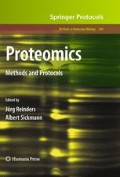Summary
Isolation and dissection of native multiprotein complexes is a central theme in functional genomics. The development of the tandem affinity purification (TAP) tag has enabled efficient and large-scale purification of native protein complexes. The SF-TAP tag, a modified version of the TAP tag, allows a fast and straightforward purification of protein complexes from mammalian cells. It consists of a tandem Strep-tag II and a FLAG epitope (SF-TAP). The SF-TAP tag allows a native elution of protein complexes without proteolytic cleavage needed in the original TAP procedure. Besides the SF-TAP protocol, the principal idea of a pathway mapping by subsequent tagging of copurified proteins is demonstrated for the interactome of the MAPKKK Raf.
Access this chapter
Tax calculation will be finalised at checkout
Purchases are for personal use only
References
Alberts, B. (1998) The cell as a collection of protein machines: preparing the next generation of molecular biologists. Cell, 92, 291–4.
Chang, I.F. (2006) Mass spectrometry-based proteomic analysis of the epitope-tag affinity purified protein complexes in eukaryotes. Proteomics, 6, 6158–66.
Gavin, A.-C., Bosche, M., Krause, R., Grandi, P., Marzioch, M., Bauer, A., Schultz, J., Rick, J.M., Michon, A.-M., Cruciat, C.-M.et al (2002) Functional organization of the yeast proteome by systematic analysis of protein complexes. Nature, 415, 141–7.
Rigaut, G., Shevchenko, A., Rutz, B., Wilm, M., Mann, M. and Seraphin, B. (1999) A generic protein purification method for protein complex characterization and proteome exploration. Nat Biotechnol, 17, 1030–2.
Gingras, A.-C., Aebersold, R. and Raught, B. (2005) Advances in protein complex analysis using mass spectrometry. J Physiol, 563, 11–21.
Bouwmeester, T., Bauch, A., Ruffner, H., Angrand, P.-O., Bergamini, G., Croughton, K., Cruciat, C., Eberhard, D., Gagneur, J., Ghidelli, S.et al (2004) A physical and functional map of the human TNF-alpha/NF-kappa B signal transduction pathway. Nat Cell Biol, 6, 97–105.
Burckstummer, T., Bennett, K.L., Preradovic, A., Schutze, G., Hantschel, O., Superti-Furga, G. and Bauch, A. (2006) An efficient tandem affinity purification procedure for interaction proteomics in mammalian cells. Nat Methods, 3, 1013–9.
Gloeckner, J., Boldt, K., Schumacher, A., Roepman, R. and Ueffing, M. (2007) A novel tandem affinity purification strategy for the efficient isolation and characterization of native protein complexes. Proteomics, 7, 4228–34.
Junttila, M.R., Saarinen, S., Schmidt, T., Kast, J. and Westermarck, J. (2005) Single-step Strep-tag purification for the isolation and identification of protein complexes from mammalian cells. Proteomics, 5, 1199–203.
Skerra, A. and Schmidt, T.G. (2000) Use of the Strep-Tag and streptavidin for detection and purification of recombinant proteins. Method Enzymol, 326, 271–304.
Gloeckner, C.J., Kinkl, N., Schumacher, A., Braun, R.J., O’Neill, E., Meitinger, T., Kolch, W., Prokisch, H. and Ueffing, M. (2006) The Parkinson disease causing LRRK2 mutation I2020T is associated with increased kinase activity. Hum Mol Genet, 15, 223–32.
den Hollander, A.I., Koenekoop, R.K., Mohamed, M.D., Arts, H.H., Boldt, K., Towns, K.V., Sedmak, T., Beer, M., Nagel-Wolfrum, K., McKibbin, M.et al. (2007) Mutations in LCA5, encoding the ciliary protein lebercilin, cause Leber congenital amaurosis. Nat Genet, 39, 889–95.
Sambrook, J. and Russell, D. (2001) Molecular Cloning: A Laboratory Manual.3rd Cold Spring Harbor Laboratory Press, New York.
Hartley, J.L., Temple, G.F. and Brasch, M.A. (2000) DNA cloning using in vitro site-specific recombination. Genome Res, 10, 1788–95.
Wessel, D. and Flugge, U.I. (1984) A method for the quantitative recovery of protein in dilute solution in the presence of detergents and lipids. Anal Biochem, 138, 141–3.
Kolch, W. (2005) Coordinating ERK/MAPK signalling through scaffolds and inhibitors. Nat Rev Mol Cell Biol, 6, 827–37.
Yu, Y.Q., Gilar, M., Lee, P.J., Bouvier, E.S. and Gebler, J.C. (2003) Enzyme-friendly, mass spectrometry-compatible surfactant for in-solution enzymatic digestion of proteins. Anal Chem, 75, 6023–8.
Acknowledgments
The authors thank Gabriele Dütsch, Elöd Körtvély, and Pia Jores for critical reading of the manuscript. This work was supported by the German Federal Ministry for Education and Research BMBF grant 031U108A/031U208A, BMBF grant 0316865A (QuantPro), and EU grants INTERACTION PROTEOME (LSHG-CT-2003-505520) and ProteomeBinders (FP6-026008). The authors C.J Gloeckner and K. Boldt contributed equally to this work.
Author information
Authors and Affiliations
Editor information
Editors and Affiliations
Rights and permissions
Copyright information
© 2009 Humana Press, a part of Springer Science+Business Media, LLC
About this protocol
Cite this protocol
Gloeckner, C.J., Boldt, K., Schumacher, A., Ueffing, M. (2009). Tandem Affinity Purification of Protein Complexes from Mammalian Cells by the Strep/FLAG (SF)-TAP Tag. In: Reinders, J., Sickmann, A. (eds) Proteomics. Methods in Molecular Biology™, vol 564. Humana Press. https://doi.org/10.1007/978-1-60761-157-8_21
Download citation
DOI: https://doi.org/10.1007/978-1-60761-157-8_21
Published:
Publisher Name: Humana Press
Print ISBN: 978-1-60761-156-1
Online ISBN: 978-1-60761-157-8
eBook Packages: Springer Protocols

